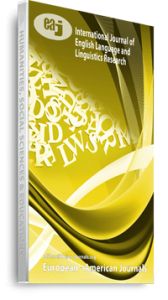In the worldwide development of modern linguistics, ‘cognitivism’ tendency is a good example with the findings of the theory and applications. One of those is an attempt of linguistic scholars from various backgrounds to continue the tradition from W. von Humboldt in Europe, E. Sapir and B. Whorf in America, who emphasize the relationship among language, thought and culture. The evidence for that are the theoretical concepts such as ‘ethno-syntax’, ‘ethno-linguistics’, ‘ethno-psycho-linguistics’ ‘cultural linguistics’, ‘human factor in language’, ‘linguistic picture of the world’, ‘linguistic consciousness’. In light of cognitive perspective, linguists often use the terms and expressions ‘different views of the world’ or ‘worldviews’, and ‘the ways in which speakers of different languages think differently’, that is to say they conceptualize or categorize experience in different ways. This view has been supported by many empirical studies within the paradigm of cognitive linguistics in the past two decades. In this area of research, from the point of cognitive view a very interesting tendency is to understand how such conceptualizations are grounded in bodily cognition. In cultural perspective, an interest in studying those conceptualizations is to explore how they have their roots in culture and how they can be different from language to another. A good evidence is linguistic data referring the different ways of conceptualizing inner body parts which function as ‘container’, ‘seat’ or ‘locus’ for human emotional and mental states or spiritual activities. In this paper, the chosen concepts related to what they are denoted in English by HEART and MIND. Particularly, conceptualizations of Heart, Belly/Abdomen, Stomach, Liver, Bowels/Intestines will be taken into consideration with cross-cultural perspective and with examples from different languages families and groups (as well as within these families and groups) in Southeast Asia which have their representatives in Vietnam as Austro-Asiatic, Austronesian, Sino-Tibertan, Hmong-Mien(Miao-Dao), Tai-Kadai. This paper denotes the evidence from following languages: (i) Austro-Asiatic: Khmer, Vietnamese, Muong; (ii) Austronesian: Cham, Ede; (iii) Sino-Tibertan: Chinese; (iv) Hmong-Mien (Miao-Dao), Hmong; (v) Tai-Kadai: Tay-Nung. For showing clearer cultural and cognitive specificity these ‘Oriental’ linguistic data are compared with a ‘Western’ one – English. It demonstrates that if English maintains a Western cultural ‘dualism’ between rationalities (MIND/HEAD) and emotions (HEART), SEA languages tend to reveal an Oriental ‘monism’: BELLY, or STOMACH, or BOWELS, or LIVER primarily uses in locating human feelings and thoughts. The difference within SEA languages in which inner organ is chosen as the locus of emotional and mental life: Vietnamese people, for example, first of all, think of the ‘inside abdomen’, but Hmong ethnic group the ‘liver’. The results of cognitive and cultural comparisons of the way of conceptualizing such inner body parts in SEA languages can make two relationships much clearer: (i) one between the ways of conceptualization and genetic features of those language families and groups; (ii) and another between the cognitively universal of human conceptualization and the culturally specific of a language community.
Keywords: Cognitive, Conceptualization, Cross-Cultural, Internal Body Organs, Mental State, Perspective, Spiritual Activity

